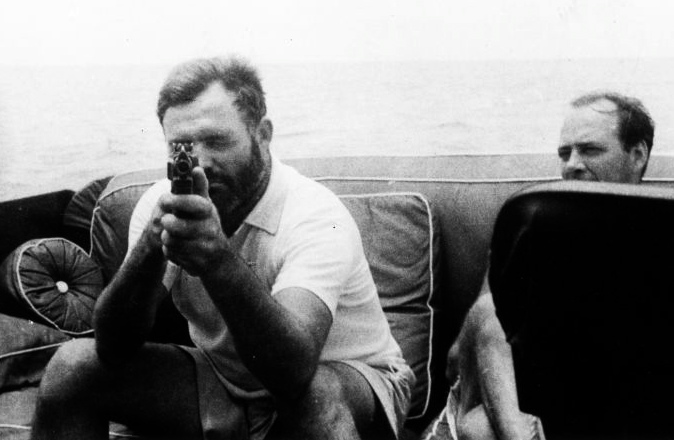“My writing is nothing. My boxing is the whole lot.” So mentioned the one and solely Ernest Hemingway, one of many twentieth century’s most charming and revered writers.
Greatest-selling literary titan. Celeb. Onerous drinker. Womanizer. Huge recreation hunter. Bull battle aficionado. Hemingway was a person’s man who wore many hats apart from that of author. And, to make certain, boxer was one of many roles he honed with real zeal. Whereas he was under no circumstances an expert fighter (extra on that later), Hemingway was most definitely a die-hard fan who favored to lace up the gloves and climb into the ring.
Simply how into boxing was Hemingway? Effectively, as a baby, he posed for an image as John L Sullivan, reflecting his early ardour for the candy science. Certainly, a number of of Hemingway’s most revered quick tales concentrate on boxing and boxers: “The Killers,” “Fifty Grand,” and “The Battler” rapidly come to thoughts. Every of those works, to various extents, are steeped within the battle recreation. Moreover, Hemingway’s basic novel, The Solar Additionally Rises, actually begins with an outline of the boxing background of Robert Cohn, one of many guide’s central characters. Make no mistake, Papa, as Hemingway got here to be affectionately referred to as, was obsessive about boxing. Obsession, although, doesn’t essentially indicate ability.
Whereas Hemingway was nothing if not courageous – documented acts of braveness on the battlefield attest to as a lot — he wasn’t precisely Gene Tunney as soon as he slipped by the ropes. Hemingway’s skill-set as a fighter could have been suited to barroom brawls, however road preventing is a far cry from scientific boxing. Though robust and aggressive, he tended to be clumsy and constantly left himself an open goal within the ring. Nonetheless, to offer credit score the place credit score is due, he endured with boxing regardless of his limitations. As with writing fiction although, coronary heart and willpower solely go up to now. One finally both has the products or doesn’t.
Enter one F. Scott Fitzgerald. Sure, that F. Scott Fitzgerald, of The Nice Gatsby fame. Scott, as he was identified to intimate associates, was dwelling in Paris concurrently Hemingway, and the 2 would go on to develop some of the peculiar friendships in literary historical past. Take into account that Fitzgerald was already a best-selling creator when he first met Hemingway, whereas Ernest, 4 years Fitzgerald’s junior, was struggling. Nonetheless, it was Fitzgerald who revered Hemingway. Hemingway, you see, was a far cry from many of the degenerate expatriates populating Paris on the time.
Overtly masculine, swaggering and gregarious, the younger World Battle One veteran — Hemingway had been severely wounded in fight whereas serving as an ambulance driver in Italy — commanded each room he entered.
Not solely might Hemingway out-drink even the wildest members of the so referred to as “Misplaced Technology” bohemian cohort, he additionally engaged in actions, like looking and boxing, that intimidated his friends and made them seem comfortable as compared. Like numerous others, Fitzgerald developed a case of hero worship. But in contrast to the general public eager to affix Hemingway’s burgeoning cult-like following, Fitzgerald was a minimum of the person’s equal as a author.
Whereas Hemingway was certainly on the precipice of rising as a literary heavyweight, Fitzgerald had already discovered enviable institution success and recognition. And provided that Hemingway’s hyper-masculinity was all the time grounded in fragility, a risk to his supremacy, in any regard, might show problematic. As such, the younger creator tried to claim himself by disrespecting and difficult Fitzgerald. Regardless of this, Scott, like so many others, largely accepted it. However such “chemistry” can result in combustion, and emotions reportedly infected one particularly heated afternoon in 1929.
By that point, Hemingway was starting to surpass Fitzgerald as an artist. Not solely did his first printed novel, The Solar Additionally Rises, shake up the world of letters, his follow-up guide, A Farewell To Arms, was (and nonetheless is) thought of a masterpiece of battle fiction. A reminder, although: Hemingway wasn’t a lot of a boxer. However limitations apart, he had some legit in-ring expertise as a consequence of sparring with the likes of Canadian author Morley Callaghan, who was a genuinely expert fighter, on a number of events.
On that 1929 day in query, nevertheless, Fitzgerald reportedly acted as timekeeper, and he apparently let the second spherical with Callaghan run a minute too lengthy. Dangerous sufficient, positive, however in these bonus sixty seconds, Callaghan put Ernest on the canvas. For a person as aggressive as Hemingway, the spherical’s perceived size was sufficient to warrant outrage and suspicion. Loudly blaming Fitzgerald for eager to see him get thrashed by Callaghan, Hemingway, as he was identified to do, escalated the scenario.

That’s, in fact, if one can belief this apocryphal story of literary violence. Hemingway is claimed to have later claimed that Fitzgerald had let the spherical prolong for an obscene ten minutes – a completely ridiculous cost. Callaghan’s testimony in regards to the incident in his autobiography, written after Fitzgerald’s loss of life, would go on to raise the story to the realm of literary legend. Curiously, Fitzgerald is claimed to have by no means printed a phrase in regards to the battle. Maybe he was ashamed, but it surely’s extra doubtless than not that the incident was quickly forgotten, solely to be revisited after reminiscences and specifics had pale, and various histories had taken root within the minds of every participant. And though he was risky by nature, Hemingway’s correspondence with Fitzgerald after that notorious day remained heat and supportive.
Nonetheless, if there’s an ethical to this story, it’s that boxing can by no means escape controversy – even amongst its very unlikely members. — Sean Crose











